Godzilla Conquers the Globe:
Japanese Movie Monsters in International Film Art
Exhibition Room #3: Kress Seminar Room
Godzilla Makes His Debut
C. V. Starr East Asian Library, Columbia University, February - December 2004
Curated by Gregory M. Pflugfelder with the assistance of Yoshiko Fredisdorf, Ria Koopmans-de Bruijn, and Derek
Lam
Exhibit map, Room #3:
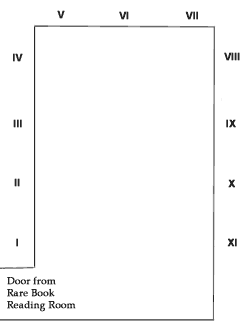 The original formula was simple,
successful, and long-lasting: a fire-breathing lizard
towers over the cityscape, clutching subway cars
in his mighty claws, utterly impervious to tank
fire and to attacking aircraft. Yet from the start,
even this powerful image left room for multiple
interpretations. With two exceptions, the posters
in this room were designed to publicize the first
Godzilla film to play in their respective countries:
the Hollywood-retailored version of 1956, titled Godzilla, King of the Monsters. While most
fit a basic pattern, they vary subtly yet significantly—and
more than in such pictorial details as whether the
monster in the image faces left or faces right.
Orientalist fantasies, marketing ploys, ideological
agendas, intertextual allusions, locally specific
conventions surrounding medium and format, all combine
to produce a surprisingly malleable, rather than
monolithically menacing, beast. Succeeding generations
of Godzilla movies, and moviegoers, evoked or experienced
a similar diversity of reactions, ranging from mirth
to melodrama to mortal terror.
The original formula was simple,
successful, and long-lasting: a fire-breathing lizard
towers over the cityscape, clutching subway cars
in his mighty claws, utterly impervious to tank
fire and to attacking aircraft. Yet from the start,
even this powerful image left room for multiple
interpretations. With two exceptions, the posters
in this room were designed to publicize the first
Godzilla film to play in their respective countries:
the Hollywood-retailored version of 1956, titled Godzilla, King of the Monsters. While most
fit a basic pattern, they vary subtly yet significantly—and
more than in such pictorial details as whether the
monster in the image faces left or faces right.
Orientalist fantasies, marketing ploys, ideological
agendas, intertextual allusions, locally specific
conventions surrounding medium and format, all combine
to produce a surprisingly malleable, rather than
monolithically menacing, beast. Succeeding generations
of Godzilla movies, and moviegoers, evoked or experienced
a similar diversity of reactions, ranging from mirth
to melodrama to mortal terror.
Poster I
| FILM TITLE (ENGLISH): |
Godzilla, King of the Monsters |
| ORIGINAL YEAR OF RELEASE: |
1956 |
| POSTER NATIONALITY: |
Belgium |
| YEAR: |
ca. 1957 |
| ARTIST: |
? |
| DIMENSIONS: |
approximately 18 x 22 inches |
| PRINTING METHOD: |
offset |
| MONSTER FEATURED: |
Godzilla |
(from the collection of Gregory M. Pflugfelder) |
|
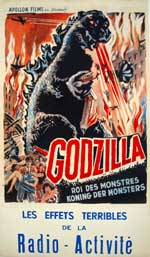 |
Belgium is a bilingual
country, and film titles and publicity catchphrases conventionally
appear on its posters in French and in Dutch. Both "Roi des Monsters"
(French) and "Koning der Monsters" (Dutch) translate as "King of the
Monsters." This particular poster likely was displayed in a francophone
locality, since an additional sheet of paper is attached to the bottom,
promising viewers in French that they will witness "the terrible effects
of radioactivity." The word "radioactivity," incidentally, is itself
originally French, emerging from the turn-of-the-century research
of Marie Curie. French-language posters like this one (see also Poster
V) emphasize the original film's antinuclear message to a far
greater degree than their anglophone counterparts. Not until 1960
would France test an atomic bomb. Ironically, the makers of Hollywood's
1998 Godzilla decided to place the blame for awakening the
prehistoric beast on French rather than on American nuclear experiments. |
Poster II
| FILM TITLE (JAPANESE): |
Gojira no gyakushû |
| (ENGLISH): |
Gigantis, the Fire Monster |
| ORIGINAL YEAR OF RELEASE: |
1955 |
| POSTER NATIONALITY: |
Belgium |
| YEAR: |
ca. 1958 |
| ARTIST: |
? |
| DIMENSIONS: |
approximately 14 x 22 inches |
| PRINTING METHOD: |
offset |
| MONSTERS
FEATURED (LEFT TO RIGHT): |
Godzilla, Gigantis |
(from the collection of Gregory M. Pflugfelder) |
|
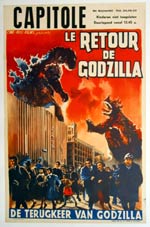 |
Godzilla returned to Japanese screens
for the second time in 1955, a year before his first feature was released
internationally. This time he was not the only monster on the block.
His foe, Angiras, appears here on the right as both monsters battle
each other on the streets of Osaka, Japan's second largest metropolis.
This Belgian poster advertised the film's screening at Ciné Capitole,
one of the largest theaters in Antwerp, a predominantly Dutch-speaking
city. Much of the information appears only in Dutch, for example,
the fact that the show ran continuously from 1:45 PM. Despite the
early hour, children were not admitted—somewhat of an irony,
considering that the kaijû eiga genre subsequently came to
be regarded by many as "kiddie fare." The poster artist was clearly
not familiar with Chinese or Japanese characters, so that the sign
on the building near the center of the image is nonsensical. Nevertheless,
he or she creates an interesting array of human types fleeing—or
at least in one case nonchalantly strolling away—from the scene
of destruction, not to mention a peculiar array of headgear. |
Poster III
| FILM TITLE (ENGLISH): |
Godzilla, King of the Monsters |
| ORIGINAL YEAR OF RELEASE: |
1956 |
| POSTER NATIONALITY: |
Romania |
| YEAR: |
1957 |
| ARTIST: |
? (after A. Poucel) |
| DIMENSIONS: |
approximately 18 x 30 inches |
| PRINTING METHOD: |
lithography |
| MONSTER FEATURED: |
Godzilla |
(from the collection of Gregory M. Pflugfelder) |
|
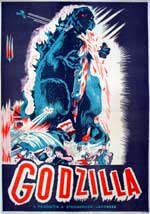 |
Godzilla's reception behind the Iron
Curtain is a story that remains to be told. In 1957, Godzilla,
King of the Monsters premiered not only in Western Europe, but
also in the Soviet satellite states of Poland and Romania. (The film
opened the same year in Cuba, but Castro's Revolution was still a
couple of years away.) Although Romanians saw the Hollywood version
with Raymond Burr, official publicity described the film as the "production
of a Japanese studio." Unlike its Slavic neighbors, Romanian is a
Romance language, and it might be partly for this reason that local
promoters chose a French design as the basis for their poster. Nevertheless,
they deleted the sensationalistic verbiage that appears on the French
original (see Poster V), including the claim that
the film exposed the "terrible consequences of atomic experiments."
Might this omission betray an uncomfortable recognition that the East
Bloc, too, relied for its security on nuclear-weapons development?
At the very least, the poster reveals the insufficiencies of the Romanian
consumer economy, as reflected in the inferior quality of the paper
on which it is printed. |
Poster IV
| FILM TITLE (ENGLISH): |
Godzilla, King of the Monsters |
| ORIGINAL YEAR OF RELEASE: |
1956 |
| POSTER NATIONALITY: |
West Germany |
| YEAR: |
1957 |
| ARTIST: |
? |
| DIMENSIONS: |
approximately 22 x 33 inches |
| PRINTING METHOD: |
offset |
| MONSTER FEATURED: |
Godzilla |
(from the collection of Gregory M. Pflugfelder) |
|
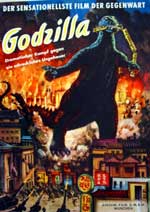 |
Like their American counterparts,
West German film publicists had switched from lithography to offset
printing by the 1950s. Even so, the posters they produced during this
era display a high level of technical skill, and retain their vibrant
colors even today. This poster's imagery exemplifies a peculiar breed
of Orientalism that indiscriminately mixes different East Asian traditions
with a large dose of the artist's own fantasy. The curved roofs of
the buildings that Godzilla is about to stomp on, for example, are
more likely to be found in a Chinese than a Japanese city. Some of
the written characters on the shop signs, meanwhile, exist in neither
country. Details aside, the artist manages effectively to convey the
sense that, as the top line of the poster phrases it, audiences would
witness "the most sensational film of contemporary times." The flaming
cityscape and smoke-filled skies in the background of the poster may
even have reminded German viewers of similar scenes of urban conflagration
in their own country's not-too-distant past. Like the unusually long
tail on this German Godzilla, memories of war and destruction can
leave a lengthy trail in the cultural imagination. |
Poster V
| FILM TITLE (ENGLISH): |
Godzilla, King of the Monsters |
| ORIGINAL YEAR OF RELEASE: |
1956 |
| POSTER NATIONALITY: |
France |
| YEAR: |
1957 |
| ARTIST: |
A. Poucel |
| DIMENSIONS: |
approximately 21 x 33 inches |
| PRINTING METHOD: |
lithography |
| MONSTER FEATURED: |
Godzilla |
(from the collection of Gregory M. Pflugfelder) |
|
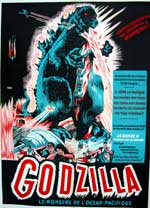 |
We have seen this monster
already in Poster III from Romania,
but stripped there of the profuse language that distinguishes the
French original. Film promoters in France emphasized that, contrary
to name of the ocean that spawned him, Godzilla was anything but pacific.
The copy inside the green box reads: |
|
A monster from the
ocean
Rises from the depths of the abyss
And attacks…
He sows panic
Ships are sunk
Trains are crushed
Skyscrapers collapse
A city disappears
Trains, cannons, tanks
Can do nothing to stop him
The H-bomb
Will it be able to destroy him?
A film that is
Gigantic
Sensational
Unforgettable
Whose realism
Surpasses the imagination! |
For
all the impending terror, the French artist has not forgotten to endow
the woman who is being carried just left of these words with a revealing
evening dress and comely legs.
[ERRATUM: The label inside the display
case should read "1957" instead of "ca. 1957."] |
Poster VI
| FILM TITLE (ENGLISH): |
Godzilla, King of the Monsters |
| ORIGINAL YEAR OF RELEASE: |
1956 |
| POSTER NATIONALITY: |
Argentina |
| YEAR: |
1957 |
| ARTIST: |
? |
| DIMENSIONS: |
approximately 29 x 43 inches |
| PRINTING METHOD: |
lithography |
| MONSTER FEATURED: |
Godzilla |
(from the collection of Gregory M. Pflugfelder) |
|
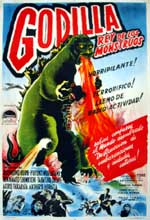 |
Although the letter D in Spanish is
pronounced more softly than in English, it is not entirely clear why
Godzilla, King of the Monsters, lost a Z when he arrived in Argentina.
In Cuba and Mexico, not to mention Spain itself, the Z remained intact.
Perhaps it was simply a typographical error. The names of some of
the monster's costars are similarly garbled. Correctly, the cast roster
should read: Raymond Burr, Fuyuki Murakami, Ren Yamamoto,
Tadashi Okabe, Akira Takarada, Akihiko Hirata. Furthermore, "Shinkichi" is not the name of an actor, but
of a character played in the movie by Suzuki Toyoaki. On a visual
level, the colorful lithography of the poster makes true on its promise
to deliver a monster that is "Horrible! Terrifying! Full of radioactivity!"
Argentinean printers, like their counterparts in such countries as
Australia, France, India, and Turkey, continued to employ traditional
lithographic methods on their film posters well into the 1960s. The
caption in red, which was used also in Cuban and Mexican publicity
materials, reads: "Experts are baffled / The world is astonished /
The destruction of ships and entire cities!" Is it my imagination,
or does Godzilla's tail appear somewhat rodentlike? |
Poster VII
| FILM TITLE (ENGLISH): |
Godzilla, King of the Monsters |
| ORIGINAL YEAR OF RELEASE: |
1956 |
| POSTER NATIONALITY: |
Australia |
| YEAR: |
ca. 1960s |
| ARTIST: |
? |
| DIMENSIONS: |
approximately 14 x 22 inches |
| PRINTING METHOD: |
lithography |
| MONSTER FEATURED: |
Godzilla |
(from the collection of Gregory M. Pflugfelder) |
|
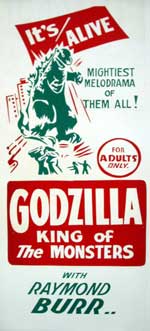 |
Melodrama, according to The American
Heritage Dictionary, is a form of "drama, such as a play, film,
or television program, characterized by exaggerated emotions, stereotypical
characters, and interpersonal conflicts." This Australian poster,
which likely publicized a 1960s rerelease of Godzilla, King of
the Monsters, is unusual in emphasizing the movie's (melo)dramatic
as much as its horrific qualities. It is uncertain whether the "FOR
ADULTS ONLY" rating that Australian censors gave the film was due
to its romantic or to its violent content. In the original movie,
a love triangle—hence the "interpersonal conflict"—involving
Ozawa Hideto (Takarada Akira), Yamane Eriko (Kôchi Momoko), and Serizawa
Daisuke (Hirata Akihiko) forms an important subplot within the larger
narrative, but it recedes to the background in most film art. (The
Takarada-Kôchi couple appears, however, on the Spanish publicity poster
[Poster IX] three spaces to the right.) For Australians,
many of whom were raised watching American television programs, Raymond
Burr was a familiar dramatic actor, known primarily from his starring
role in the detective series Perry Mason (1957-1966). Whereas
the French poster (Poster V) two spaces to the left,
for example, does not even mention Burr's name, Australian publicists
gave the Hollywood actor conspicuous billing. Indeed, there is little
about the poster to reveal the fact that what was in store for viewers
was a largely made-in-Japan production. This "whitewashing" of Godzilla
contrasts with most of the other items in the room (the Danish poster
[Poster VIII] to its right is a notable exception),
which indicate the film's Japanese origin either explicitly, implicitly
in the names of the cast and crew, or through Orientalized imagery.
Australian posters such as this daybill (a vertical format similar
to the U.S. "insert") were used also in New Zealand. |
Poster VIII
| FILM TITLE (ENGLISH): |
Godzilla, King of the Monsters |
| ORIGINAL YEAR OF RELEASE: |
1956 |
| POSTER NATIONALITY: |
Denmark |
| YEAR: |
1957 |
| ARTIST: |
? |
| DIMENSIONS: |
approximately 24 x 33 inches |
| PRINTING METHOD: |
offset |
| MONSTER FEATURED: |
Godzilla |
(from the collection of Gregory M. Pflugfelder) |
|
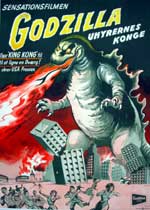 |
"Makes King Kong look like a midget!
wrote the US press," gushes this poster from Denmark. The comparison
may have been exaggerated, but American publicists—more specifically,
the New York Daily News—had indeed made such a claim the
previous year. The cartoonlike simplicity and rich lithography of
the Danish poster are captivating. Note the suggestion of a forked
reptilian tongue in the monster's fiery breath. Within four years,
Denmark would produce its own knockoff version of Godzilla, namely,
the title creature of the 1961 film Reptilicus. The Danish
thriller, made by local director Poul Bang together with American
Sidney W. Pink, tells the story of a frozen dinosaur that is unearthed
in a copper-mining operation above the Arctic Circle and brought back
to life by scientists. Reptilicus nearly destroys Copenhagen before
being finally put down by NATO troops. Without the nuclear-weapons
angle of 1954's Gojira, the political edge of the Danish film
is rather dull—unless one chooses to view it as a jab at the
mining industry. Denmark was not the only European country to copy
the prehistoric-monster-reawakened formula of Godzilla in the years
immediately after the Japanese monster's 1957 debut on that continent.
In 1959, British filmmakers created their own G-monster: Gorgo, a
saurian who emerges off the coast of Ireland in the wake of a volcanic
eruption, and whose even more terrifying mother lays waste not to
Tokyo or Copenhagen but to London. Another British wannabe is Behemoth,
the Sea Monster ("THE BIGGEST THING SINCE CREATION"), also from
1959, whose title creature, like his Japanese predecessor, is accidentally
revived as the result of nuclear-weapons testing. At one point in
the film, a Cornish fisherman who dies after being exposed to Behemoth's
radioactive rays is pointedly described as exhibiting the "same symptoms
as Hiroshima." |
Poster IX
| FILM TITLE (ENGLISH): |
Godzilla, King of the Monsters |
| ORIGINAL YEAR OF RELEASE: |
1956 |
| POSTER NATIONALITY: |
Poland |
| YEAR: |
1957 |
| ARTIST: |
Alicja Waszewska-Laurman |
| DIMENSIONS: |
approximately 23 x 33 inches |
| PRINTING METHOD: |
lithography |
| MONSTER FEATURED: |
Godzilla |
(from the collection of Gregory M. Pflugfelder) |
|
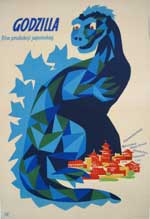 |
This poster may be the only one in
the room to have been designed by a female artist. Whether or not
gender has anything to do with it, the Godzilla depicted here is unusually
peaceable, even sort of cute. The full title of the film when released
in Poland was Godzilla [or Godzila], morsko cudoviste—"Godzilla,
the Sea Monster." Waszewska-Laurman's Orientalist imagery conveys
the air of a poster for exotic travel to a foreign country, a luxury
that was unavailable to most Poles under Communist rule. The sloping
roofs and pagodas in the poster seem vaguely Chinese, although the
copy states that the film is a "Japanese production." The theater
program accompanying the movie's Polish release may be seen upstairs
in Display
Case B. Godzilla, King of the Monsters was one of the first
Hollywood-marketed films to play in Poland after the post-Stalinist
thaw of the mid-1950s. Long before the Cold War ended, audiences not
only in Poland but also in such Communist states as Czechoslovakia,
Hungary, Romania (see Poster III), and Yugoslavia
were able to visit Japan through the medium of kaijû eiga. |
Poster X
| FILM TITLE (ENGLISH): |
Godzilla, King of the Monsters |
| ORIGINAL YEAR OF RELEASE: |
1956 |
| POSTER NATIONALITY: |
Spain |
| YEAR: |
ca. 1957 |
| ARTIST: |
Macario Gómez ("Mac") |
| DIMENSIONS: |
approximately 27 x 41 inches |
| PRINTING METHOD: |
offset |
| MONSTER FEATURED: |
Godzilla |
(from the collection of Gregory M. Pflugfelder) |
|
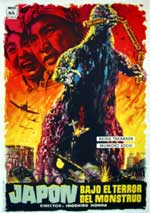 |
This is the sole poster in the room
that does not mention Godzilla by name (whether spelled correctly
or not). Instead, Spanish publicists promised viewers that they would
witness "Japan under the Terror of the Monster." As earlier noted,
the couple who are at heart of the film's romantic subplot, played
by Takarada Akira and Kôchi Momoko, appear in the poster's top left
corner, although it is hardly love that shows in their faces. The
name of Japanese director Honda Ishirô is given here as Inoshiro Honda.
This is a common mistransliteration in overseas materials; even some
Japanese get the director's given name wrong when they read its characters,
which can be pronounced in more than one way. In advance of a movie's
opening, Spanish theaters distributed handbills (programas de mano),
also known as heralds, which were usually smaller versions of the
full-sized poster. Two examples may be seen in Display
Case B upstairs. The reverse side of one indicates that "Cinema
Mari" (location undetermined) featured Godzilla, King of the Monsters as its special New Year's Day show in 1957. It further added that
the film was "appropriate for all audiences." Spanish children, one
can only conclude, were more mature than their counterparts in Australia
and Belgium, who were barred from viewing it altogether. What was
similar to Australia, however, was local publicists' emphasis on melodrama:
as the herald put it, "Every scene of this extraordinary production
[serves up] a heap of emotions." |
Poster XI
| FILM TITLE (JAPANESE): |
Gojira tai Mekagojira |
| (ENGLISH): |
Godzilla vs. the Bionic Monster |
| ORIGINAL YEAR OF RELEASE: |
1974 |
| POSTER NATIONALITY: |
Poland |
| YEAR: |
1977 |
| ARTIST: |
Maciej Zbikowski (1935-?) |
| DIMENSIONS: |
approximately 23 x 33 inches |
| PRINTING METHOD: |
lithography |
| MONSTER FEATURED: |
Godzilla? Mechagodzilla? |
(from the collection of Gregory M. Pflugfelder) |
|
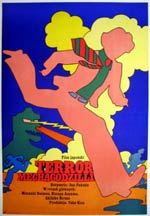 |
Fashions change. By the 1970s, Godzilla—or
rather, his evil space twin, Mechagodzilla—had donned a metallic
suit. To Americans, who were watching a lot more TV than they did
when the original Godzilla arrived on their shores, the titanium cyborg
was introduced as the Bionic Monster, a transparent attempt to cash
in on the current television popularity of the Bionic Man (played
by Lee Majors in The Six Million Dollar Man [1974-1978]) and
the Bionic Woman (Lindsay Wagner in The Bionic Woman [1976-1978]).
Even behind the Iron Curtain, men were running around the streets
in bell-bottomed trousers, wide neckties, and long hair. The 1950s
through 1970s are regarded as the Golden Age of the Polish film poster,
and this example amply conveys the genius of local artists in this
medium. Critics are divided as to whether to interpret their collective
creativity as a form of resistance against the conformity of Communist
culture or, conversely, as the result of being free to develop their
art without having to bow to capitalistic market pressures. Maciej
Zbikowski is known for his satirical cartoons and drawings, which
appeared in such weekly magazines as Szpilki and Polska.
He worked also in an animation studio, which contributed to the distinctive
style of this and many other film posters that he created between
1965 and 1979. |
SEE MORE OF THE EXHIBITION IN ROOM 1 and ROOM 2
Godzilla (R), all related characters and the character designs are trademarks
of Toho Co., Ltd.
© Gregory M. Pflugfelder
 The original formula was simple,
successful, and long-lasting: a fire-breathing lizard
towers over the cityscape, clutching subway cars
in his mighty claws, utterly impervious to tank
fire and to attacking aircraft. Yet from the start,
even this powerful image left room for multiple
interpretations. With two exceptions, the posters
in this room were designed to publicize the first
Godzilla film to play in their respective countries:
the Hollywood-retailored version of 1956, titled Godzilla, King of the Monsters. While most
fit a basic pattern, they vary subtly yet significantly—and
more than in such pictorial details as whether the
monster in the image faces left or faces right.
Orientalist fantasies, marketing ploys, ideological
agendas, intertextual allusions, locally specific
conventions surrounding medium and format, all combine
to produce a surprisingly malleable, rather than
monolithically menacing, beast. Succeeding generations
of Godzilla movies, and moviegoers, evoked or experienced
a similar diversity of reactions, ranging from mirth
to melodrama to mortal terror.
The original formula was simple,
successful, and long-lasting: a fire-breathing lizard
towers over the cityscape, clutching subway cars
in his mighty claws, utterly impervious to tank
fire and to attacking aircraft. Yet from the start,
even this powerful image left room for multiple
interpretations. With two exceptions, the posters
in this room were designed to publicize the first
Godzilla film to play in their respective countries:
the Hollywood-retailored version of 1956, titled Godzilla, King of the Monsters. While most
fit a basic pattern, they vary subtly yet significantly—and
more than in such pictorial details as whether the
monster in the image faces left or faces right.
Orientalist fantasies, marketing ploys, ideological
agendas, intertextual allusions, locally specific
conventions surrounding medium and format, all combine
to produce a surprisingly malleable, rather than
monolithically menacing, beast. Succeeding generations
of Godzilla movies, and moviegoers, evoked or experienced
a similar diversity of reactions, ranging from mirth
to melodrama to mortal terror.









